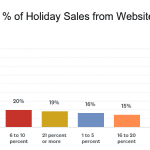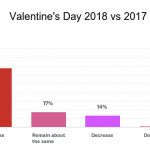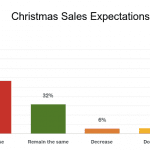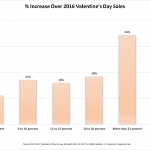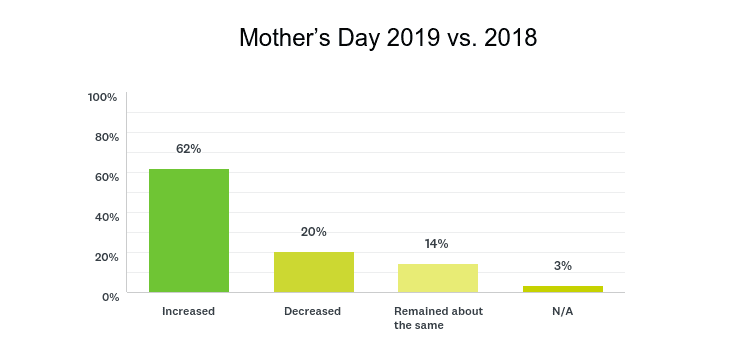
Mother’s Day 2019 proved to be another strong holiday for the floral industry, with 62 percent of retailer respondents to a Society of American Florists post-holiday survey saying sales were higher than their 2018 returns. Among those who saw sales rise, 42 percent said the increase was between 1 percent and 10 percent; another 25 percent saw gains between 11 percent and 20 percent.
The survey results also highlighted a trend in last-minute ordering and showed an upward curve in average transactions.
This week, we’ll take a deep dive into the survey results and share some feedback from members of SAF’s Retailers Council. Look for additional holiday reporting, including results from a separate consumer survey commissioned by SAF, next week.
Holiday Buzz
The positive take reflected in the SAF survey is consistent with previous years; in both 2018 and 2017, about 60 percent of SAF retailer members reported increased holiday sales for Mother’s Day. It’s also consistent with pre-holiday expectations: Before Mother’s Day this year, about 56 percent of respondents said they were planning for a sales increase of up to 10 percent.
More good news from the survey: The average transaction this year was almost $76, compared to $68 in 2018.
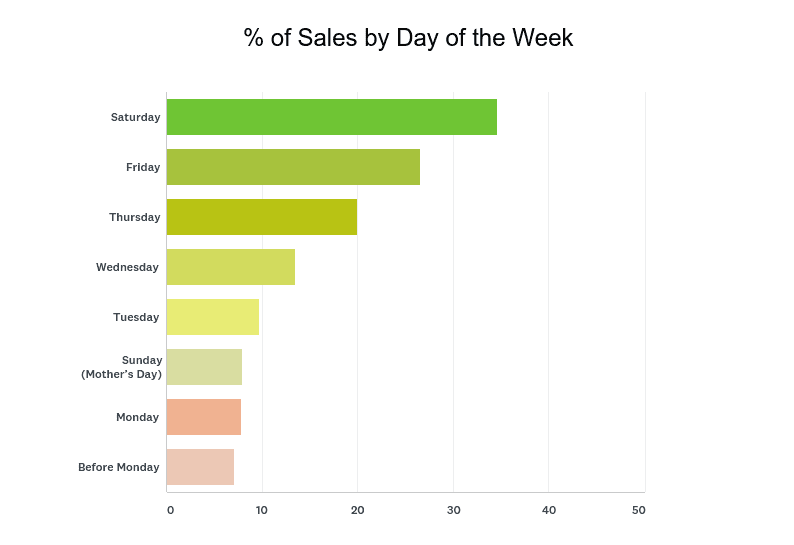
“This was a great holiday,” wrote a retailer in New York. “ very strong walk-in sales. We prepared a lot of plants, planters and pre-made bouquets ahead of time so that we had something for everyone to choose from, even when we had to cut back on offering arrangements due to excessive order amounts.”
Another respondent, this time from Virginia, said the year’s holiday was strong, if a bit unusual in the build-up.
“I thought I was down, but in the end, I was up just a bit,” she said. “We had a big prom on the same weekend, which for us was the first time in over 22 years, but staff made it work with lots of planning and organizing.”
The SAF survey was emailed to the association’s retailer members on May 20 and has a response rate of 5.9 percent response rate.
Other Highlights from the SAF Survey
Last-Minute Hustle. While florists have for a number of years been sharing anecdotal stories of more last-minute orders, this year’s survey showed proof of that trend.
On average respondents said that about 35 percent of their holiday orders arrived on Saturday, just a day before Mother’s Day. That’s a change from last year and 2017, when respondents said they received about 20 percent of orders on Saturday. (Other high-volume days this year included Friday, 27 percent, and Thursday, 20 percent.)
“People are waiting longer and longer to order,” wrote a retailer in Colorado. “The Internet has spoiled them into thinking they can wait and order the day before or day of…Usually , the orders kick in Tuesday. This year Wednesday.”
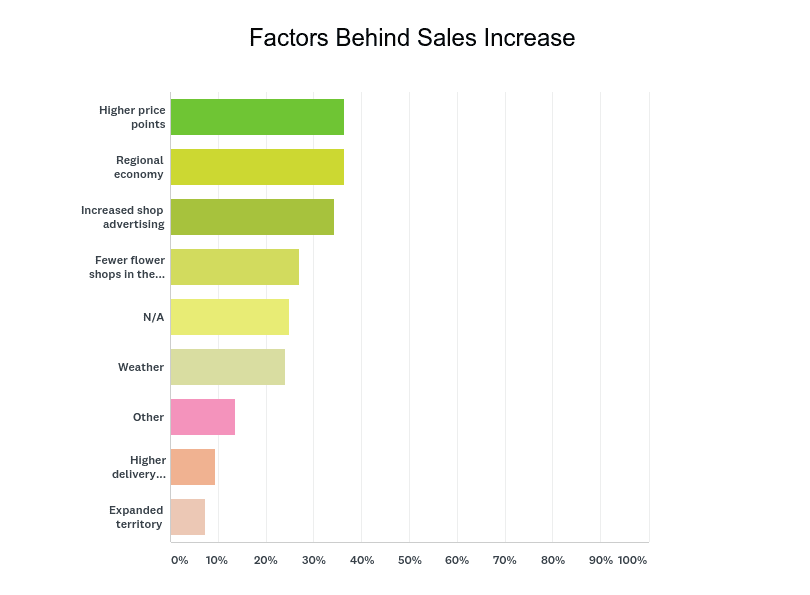
SAF Retailers Council Member Jeremy Lohman Scott’s House of Flowers in Lawton, Oklahoma, said sales were up by about 11 percent across his two locations — but his business prepped mightily before the big day to get ready for the last-minute business.
“We had a full production crew going for the week prior to make 1,500 bouquets so that we were ready for the rush,” he explained. “The years prior, I had been doing most advertising as early as possible. With the trend lately of last-minute orders, I focused my advertising in a tighter group of dates closer to the holiday so people would remember our store when they did decide to order.”
Lohman said he thinks that approach — adapt to customers’ preferences rather than try to change them — paid off.
“This trend of last-minute orders is part of our society getting used to online retailers having everything one needs whenever they need it,” he added. “ may think that flowers are not much different, and that there’s no need to pre-order any sooner than they need to. We have to be ready with inventory at all times.”
Sales by Location, Size. Self-described suburban florists were slightly more likely than the overall group to have experienced an increase for this holiday — 67 percent of this group reported higher sales — and rural florists were less likely to have experienced a holiday bump — only 25 percent of this group said sales were up.
When looking at answers by size, larger operations, those with $1 million or more in annual sales, were more likely than smaller businesses to have experienced an increase. (About 71 percent of those larger businesses reported a sales spike.)
Factors Behind Increases and Decreases. The top three factors credited by florists with increased sales were regional economy (37 percent); higher price points (37 percent); increased shop advertising and promotion (34 percent).
The top factors behind sales decreases were competition from mass marketers/supermarkets (20 percent) competition from other gift/non-floral vendors (16 percent) and the weather (13 percent).
Overall, the top three competitors listed by respondents for the holiday were order-gatherers (46 percent said this group represented their top competitor); supermarkets and grocery stores, listed by 38 percent as the No. 1 challenge; and garden centers and nurseries, pinned as top competitor by 38 percent.
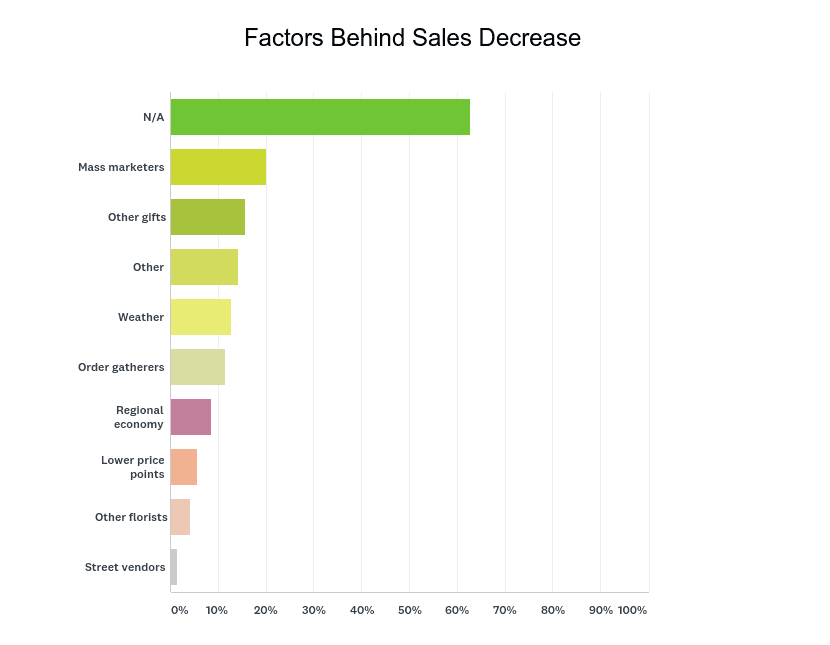
Sales by Source. On average, respondents said they received 42 percent of holiday orders via phone; 24 percent from walk-in customers; 20 percent from their website; 17 percent from wire services and/or order-gatherers; and 6 percent from other sources. (These numbers all track closely with last year’s answers.)
Retailers Council Member Nikki Lemler of Welke’s in Milwaukee said her business saw sales increase by about 16 percent — a change she attributed to a new website. “We did see a lot of last-minute orders but were better prepared,” she noted, underlining the last-minute trend once more. “One interesting thing I noticed was our outgoing orders were up 2 percent.”
Volume Control. About 35 percent of respondents said that they never suspended incoming orders; a quarter did so on Saturday; 19 percent cut them off on Friday and 5 percent did so Sunday. Meanwhile, 55 percent of respondents said they never cut off orders completely; 21 percent said they did so on Saturday.
In a number of write-in responses, florists noted that timing of the holiday, in the context of other local events, played a big role in such decisions.
“We also had a very large prom, funerals and wedding for Mother’s Day that impacted our ability to accept all incoming orders,” explained a florist in Wisconsin. “It was the first time ever that we needed to suspend our wire services late Friday and into Saturday morning to catch up. We all got about three hours sleep. It was the busiest we have seen in a long time.”
Look for more coverage of Mother’s Day and other spring holidays in future SAF publications.
Mary Westbrook is the editor in chief of Floral Management magazine.
